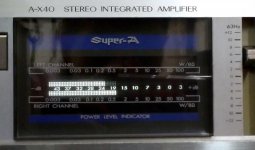I don't think it has to be a wav file for your music. I use mediamonkey player which is available for android as well as windows. I think all mediaplayers will be able to play flac, wav, mp3 whatever you have. I set the max volume for music from flac files but still used mediamonkey to play the wav file for the voltage measurement. I think the point is that cos it's all digital source the levels will always be the same.
Hope I've got this right! otherwise I'll be doing it again
Hope I've got this right! otherwise I'll be doing it again
I think the point is that cos it's all digital source the levels will always be the same.
Hope I've got this right! otherwise I'll be doing it again
That makes sense to me. It's got to be the case hasn't it? A digital code is a digital code, it has no intrinsic level of it's own?
That makes sense to me. It's got to be the case hasn't it? A digital code is a digital code, it has no intrinsic level of it's own?
That's right, but the playback device does have its own intrinsic level. That is why you have to keep things consistent through the test.
If Pano's files were uploaded as a YouTube clip then you couldn't be certain that you would see the same levels streaming the YT version compared to playing the files locally on your pc. It not the absolute levels that matter, its treating both the same so that both have the same 'difference' ratio.
I wouldn't like to say without testing it.
Its like saying that BBC1 plays a CD and ITV plays the same CD and you record the programs on DVD and play it back. All three could well play back at different audio levels.
You need consistency.
Try this at 35 minutes in. This is ideal. If you want an excerpt I'll put Pano's test file and this together.
https://youtu.be/nMViOrqBzPk?t=2101
Its like saying that BBC1 plays a CD and ITV plays the same CD and you record the programs on DVD and play it back. All three could well play back at different audio levels.
You need consistency.
Try this at 35 minutes in. This is ideal. If you want an excerpt I'll put Pano's test file and this together.
https://youtu.be/nMViOrqBzPk?t=2101
The CD of your choice means that it is you that sets the maximum listening level.
That then becomes a reference point as to the absolute maximum voltage you will ever put across your speaker because you have decided that the playback level is as loud as anything you would ever listen to.
We could then play a 0db tone and measure your actual voltage across the speaker but that would be damaging and far to loud. So we use a lower amplitude test tone and calculate back from that what the equivalent 0db voltage would have been and thus can calculate the power.
I'll put that together a little later today.
That then becomes a reference point as to the absolute maximum voltage you will ever put across your speaker because you have decided that the playback level is as loud as anything you would ever listen to.
We could then play a 0db tone and measure your actual voltage across the speaker but that would be damaging and far to loud. So we use a lower amplitude test tone and calculate back from that what the equivalent 0db voltage would have been and thus can calculate the power.
I'll put that together a little later today.
Yes I understand that, but it again brings me back to so long as the source is the same and the volume control is not touched it should make no difference, as you say, it works because it is a relative test. Sorry if there is something I'm missing, it stands a good chance! Thanks for your help.
I should measure for each amp output?
Yes, because you need to know the levels you are using. I think Pano did some subwoofer files, you'll have to read through the thread to find them.
Yes I understand that, but it again brings me back to so long as the source is the same and the volume control is not touched it should make no difference, as you say, it works because it is a relative test. Sorry if there is something I'm missing, it stands a good chance! Thanks for your help.
I've sent you a link for the files. They are not compressed and you have a choice of WAV or MP3.
You should see something like this for each. Click the dropdown and select direct download.
Attachments
Is that doing the calculation to bring it back up to 0dB? I could have gone a bit louder but I would have found it uncomfortable. I know I do listen at what many people would consider a low level. Before I built a loudspeaker protection circuit I used 100mA fuses! They did blow occasionally......
Last edited:
Pano picked the levels of the digital test signal such that the maths worked out easily. That is what made the test so clever.
Squaring the rms voltage you measured gives the amplifier power needed to produce your maximum listening level assuming nominal 8 ohm speakers.
Remember the test is really about how much voltage you need rather than power. There is a variable introduced by your speaker impedance.
So what we say is that your amplifier needs to be a capable of 62 milliwatts into 8 ohms.
That equates to a voltage of 0.7 volts rms. The test has determined the voltage you put across your speakers with music at your chosen maximum level.
Now if your speakers are 3 ohm then you need to ensure your amplifier is capable of maintaining that voltage into that impedance.
So we can say that if you did have 3 ohm speakers then you need a 0.16 watts rms amplifier that can drive 3 ohms.
Have a read at this and some of Pano's earlier calculations:
http://www.diyaudio.com/forums/mult...-power-do-your-speakers-need.html#post2879967
Are you surprised its so low ?
Squaring the rms voltage you measured gives the amplifier power needed to produce your maximum listening level assuming nominal 8 ohm speakers.
Remember the test is really about how much voltage you need rather than power. There is a variable introduced by your speaker impedance.
So what we say is that your amplifier needs to be a capable of 62 milliwatts into 8 ohms.
That equates to a voltage of 0.7 volts rms. The test has determined the voltage you put across your speakers with music at your chosen maximum level.
Now if your speakers are 3 ohm then you need to ensure your amplifier is capable of maintaining that voltage into that impedance.
So we can say that if you did have 3 ohm speakers then you need a 0.16 watts rms amplifier that can drive 3 ohms.
Have a read at this and some of Pano's earlier calculations:
http://www.diyaudio.com/forums/mult...-power-do-your-speakers-need.html#post2879967
Are you surprised its so low ?
I had a rough idea of the voltage as I'd measured it very inaccurately with DMM whilst playing music a while ago, and of course getting away with a 100mA fuse most of the time. The wattage does surprise me, but, thinking about it, that's what happens when you multiply fractions haha! The law of diminishing returns rules very large in this game.
I did the test with maximum bass treble (Audio sacrilege, Please dont shoot me.) and also with tone defeat. Here are the details.
Speakers : DIY three way first order crossover speakers of unknown parameters (Howevers all drivers i.e. tweeter, mid and woofer are 8 ohms), Amplifier : JVC A-X40, CD Player : Generic, Multimeter : Digital with 200mv AC measurements and above, Room Size : 18' x 10' x 9.5' (feet), Music : 'Shoot to thrill' from AC/DC 'Back in black' album.
Measurements :
With music playing : 6.2 V at speaker terminal max.
120 hz With Bass and treble at maximum : 6.6v
120 hz With Tone defeat (Direct) : 3.4v
220 hz With Bass and treble at maximum : 2.7v
220 hz With Tone defeat (Direct) : 2v
Interesting tidbits : Amplifier is 50 W into 8 ohms. I think with 220/250k volume pot potentiometer, with 10 segments markings on face plate I played unbearable loud at 1.5/2 marking point. I know VU meters are not good reference to see power required but on amplifier VU display it never went past 2w marking. (See pic attached) Don't know if all this is helpfull.
So max voltage is 6.6v and min. 2v. So I guess (6.6x4)(6.6x4)/8 I will need approx 88watts max if I use tone controls AND (2x4)(2x4)/8 = 2watts with direct playing. Right ?
Please be gentle. Noob here.
 Warm regards.
Warm regards.
Speakers : DIY three way first order crossover speakers of unknown parameters (Howevers all drivers i.e. tweeter, mid and woofer are 8 ohms), Amplifier : JVC A-X40, CD Player : Generic, Multimeter : Digital with 200mv AC measurements and above, Room Size : 18' x 10' x 9.5' (feet), Music : 'Shoot to thrill' from AC/DC 'Back in black' album.
Measurements :
With music playing : 6.2 V at speaker terminal max.
120 hz With Bass and treble at maximum : 6.6v
120 hz With Tone defeat (Direct) : 3.4v
220 hz With Bass and treble at maximum : 2.7v
220 hz With Tone defeat (Direct) : 2v
Interesting tidbits : Amplifier is 50 W into 8 ohms. I think with 220/250k volume pot potentiometer, with 10 segments markings on face plate I played unbearable loud at 1.5/2 marking point. I know VU meters are not good reference to see power required but on amplifier VU display it never went past 2w marking. (See pic attached) Don't know if all this is helpfull.
So max voltage is 6.6v and min. 2v. So I guess (6.6x4)(6.6x4)/8 I will need approx 88watts max if I use tone controls AND (2x4)(2x4)/8 = 2watts with direct playing. Right ?
Please be gentle. Noob here.
Attachments
- Home
- Loudspeakers
- Multi-Way
- A Test. How much Voltage (power) do your speakers need?

